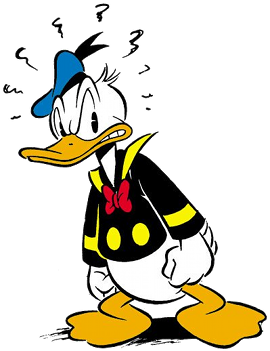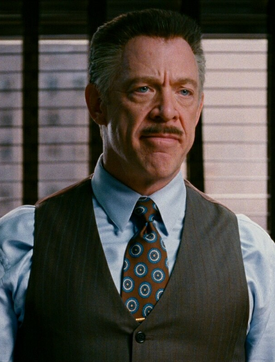
Daisy Duck is an American cartoon character created by the Walt Disney Company. As the girlfriend of Donald Duck, she is an anthropomorphic white duck that has large eyelashes and ruffled tail feathers around her lowest region to suggest a skirt. She is often seen wearing a hair bow, blouse, and heeled shoes. Daisy was introduced in the short film Mr. Duck Steps Out (1940) and was incorporated into Donald's comic stories several months later. Carl Barks, the screenwriter and lead storyboard artist for the film, was inspired by the 1937 short, Don Donald, that featured a Latin character named Donna Duck, to revive the concept of a female counterpart for Donald.

The Mickey Mouse universe is a fictional shared universe which is the setting for stories involving Disney cartoon characters, including Mickey and Minnie Mouse, Donald and Daisy Duck, Pluto and Goofy as the primary members, and many other characters related to them, being most of them anthropomorphic animals. The universe originated from the Mickey Mouse animated short films produced by Disney starting in 1928, although its first consistent version was created by Floyd Gottfredson in the Mickey Mouse newspaper comic strip. Real-world versions also exist in Disneyland and Tokyo Disneyland, called Mickey's Toontown.

Horace Horsecollar is a cartoon character created in 1929 at Walt Disney Animation Studios. Horace is a tall anthropomorphic black horse and is one of Mickey Mouse's best friends. Characterized as a boastful show-off, Horace served as Mickey’s sidekick in Disney's early black-and-white shorts.

John Dezso Ratzenberger is an American actor. He is best known for playing the character Cliff Clavin on the comedy series Cheers, for which he earned two Primetime Emmy nominations. Ratzenberger also played a role in the short-lived spin-off The Tortellis and in an episode of Wings, which was made by the same creators. He has voiced various characters in several Pixar animated feature films including Hamm in the Toy Story franchise, The Abominable Snowman in the Monsters, Inc. franchise, Mack in the Cars franchise, The Underminer in The Incredibles franchise, Fritz in the Inside Out franchise, and many others.

A cameo appearance, also called a cameo role and often shortened to just cameo, is a brief guest appearance of a well-known person or character in a work of the performing arts. These roles are generally small, many of them non-speaking ones, and are commonly either appearances in a work in which they hold some special significance or renowned people making uncredited appearances. Short appearances by celebrities, film directors, politicians, athletes or musicians are common. A crew member of the movie or show playing a minor role can be referred to as a cameo role as well, such as director Alfred Hitchcock who made frequent cameo appearances in his films.

Batman is an American live-action television series based on the DC Comics character of the same name. It stars Adam West as Bruce Wayne/Batman and Burt Ward as Dick Grayson/Robin—two crime-fighting heroes who defend Gotham City from a variety of archvillains. It is known for its camp style and upbeat theme music, as well as its intentionally humorous, simplistic morality aimed at its preteen audience. It was described by executive producer William Dozier at the time as "the only situation comedy on the air without a laugh track". The 120 episodes aired on the ABC network for three seasons from January 12, 1966, to March 14, 1968, twice weekly during the first two seasons, and weekly for the third. In 2016, television critics Alan Sepinwall and Matt Zoller Seitz ranked Batman as the 82nd greatest American television series of all time. A companion feature film was released in 1966 between the first and second seasons of the TV show.

Basil Brush is a fictional fox, best known for his appearances on daytime British children's television. He is primarily portrayed by a glove puppet, but has also been depicted in animated cartoon shorts, books, annuals and comic strips. The character has featured on children's television from the 1960s to the present day. He has also appeared in pantomimes across the UK.

A crossover is the placement of two or more otherwise discrete fictional characters, settings, or universes into the context of a single story. They can arise from legal agreements between the relevant copyright holders, common corporate ownership or unofficial efforts by fans.

Happy Tree Friends is an American adult animated web series created by Aubrey Ankrum, Rhode Montijo, and Kenn Navarro, and developed by Montijo, Navarro, and Warren Graff for Mondo Media. Disguised as a kids' cartoon, the show follows the misadventures of cute anthropomorphic forest animals, whose initially peaceful lives always end with sudden, usually accidental, graphically violent incidents. Debuting on December 24, 1999, Happy Tree Friends has achieved a cult following on Mondo's website and YouTube channel and expanded into a multimedia franchise, which includes the television series of the same name.
In acting, a bit part is a role in which there is direct interaction with the principal actors and no more than five lines of dialogue, often referred to as a five-or-less or under-five in the United States, or under sixes in British television, or a walk-on part with no dialogue.
In American comic books and other stories with a long history, first appearance refers to the first issue to feature a fictional character. These issues are often highly valued by collectors due to their rarity and iconic status.
A post-credits scene is a short teaser clip that appears after the closing credits have rolled and sometimes after a production logo of a film, TV series, or video game has run. It is usually included to reward the audience for having the patience to watch through the credits sequence; it may be a scene written for humour or to set up a sequel.
A spin-off or spinoff is any narrative work derived from an already existing work that focuses on different aspects from the original work.

Navdeep Pallapolu is an Indian actor and television personality who predominantly appears in the Telugu film industry alongside Tamil and Hindi works. He made his film debut in 2004 with the patriotic sports drama Jai. His notable works include Arinthum Ariyamalum (2005), Gowtam SSC (2005), Chandamama (2007), Arya 2 (2009), Baadshah (2013), Ice Cream (2014), Dhruva (2016), Nene Raju Nene Mantri (2017), Ragini MMS: Returns 2 (2019), Ala Vaikunthapurramloo (2020), Seeru (2020), Masti's (2020), Run (2020), Newsense, (2023) and Eagle (2024).

Donald Duck is a cartoon character created by The Walt Disney Company. Donald is an anthropomorphic white duck with a yellow-orange bill, legs, and feet. He typically wears a sailor shirt and cap with a bow tie. Donald is known for his semi-intelligible speech and his mischievous, temperamental, and pompous personality. Along with his friend Mickey Mouse, Donald was included in TV Guide's list of the 50 greatest cartoon characters of all time in 2002, and has earned a star on the Hollywood Walk of Fame. He has appeared in more films than any other Disney character.

Sleeping Beauty is a Disney media franchise that began in 1959 with the theatrical release of the animated film Sleeping Beauty, based on the homonymous fairy tale.

J. Jonah Jameson (JJJ) is a fictional character portrayed by J. K. Simmons in both Sam Raimi's Spider-Man trilogy and the Spider-Verse franchise produced by Sony Pictures, and the Marvel Cinematic Universe (MCU) media franchise co-produced with Marvel Studios. Based on the Marvel Comics character by Stan Lee and Steve Ditko, he was adapted to screen by David Koepp, Sam Raimi, Chris McKenna, Erik Sommers, and Jon Watts.












